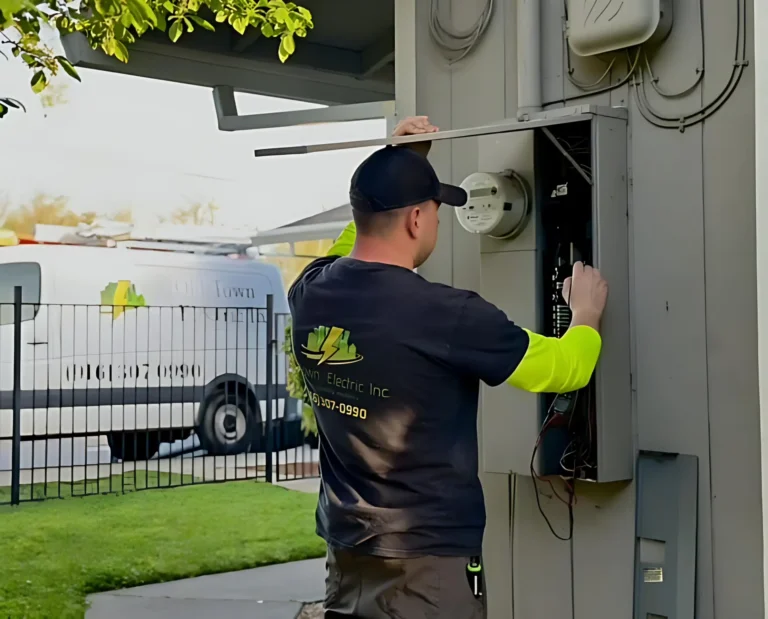If you own a home in Sacramento, chances are you’ve heard the term Arc Fault Breaker tossed around, maybe by an inspector, a contractor, or even a neighbor doing renovations. But do you really need them? And more importantly, are they worth the cost and hassle of installing?
As someone who’s been wiring homes, replacing panels, and troubleshooting electrical issues across the Sacramento Valley for years, I can tell you this isn’t just a “code requirement” conversation. It’s about protecting your family, your property, and in some cases, your wallet.
What Exactly Is an Arc Fault Breaker?
An Arc Fault Circuit Interrupter (AFCI), often called an arc fault breaker, is designed to detect dangerous electrical arcs that standard breakers miss.
Think about it like this: a regular breaker protects against overloads and short circuits. An AFCI goes a step further, it recognizes the kind of sparking that happens when a wire gets damaged, pinched, or worn down.
I’ve seen plenty of homes in Sacramento, especially older ones in areas like East Sacramento and Land Park, where insulation on wiring gets brittle from summer heat in attics. That’s a recipe for arcs. And arcs? They’re one of the leading causes of electrical fires.
Why Arc Fault Breakers Matter in Sacramento
Hot Summers and Aging Homes
Sacramento’s triple-digit summers take a toll on electrical systems. Attic wiring bakes for months, insulation breaks down, and homeowners run fans, portable AC units, and extra appliances, pushing circuits harder than they were designed for.
That’s when hidden arcs show up. A breaker that doesn’t catch them won’t trip, and you might never know until there’s smoke.
Local Building Codes
The California Electrical Code (which mirrors the National Electrical Code, with some local amendments) requires AFCIs in many parts of the home. Bedrooms were the first to be included years ago, but today most living spaces, family rooms, dining rooms, and even hallways, need arc fault protection.
When we update panels or pull permits for remodels in Sacramento, inspectors from the city are clear: if it falls under current code, it needs arc fault breakers.
Do All Homes Need Arc Fault Breakers?
Here’s the thing, if your home was built before the mid-2000s, it likely doesn’t have arc fault breakers. And unless you’re upgrading your panel or doing major remodel work, you’re not required to retrofit them.
That said, I’ve worked on homes from Curtis Park to Natomas where owners chose to upgrade anyway, especially after close calls like:
- Burnt outlets behind a couch where cords were pinched.
- Flickering lights that turned out to be arcing in the wall.
- A faint “burning smell” in a bedroom traced back to an arc in the wiring.
Were those homes required to have arc fault breakers? No. But once the homeowners saw the risk firsthand, they didn’t think twice about the upgrade.
Arc Fault Breaker vs. GFCI: What’s the Difference?
This one confuses a lot of people.
- AFCI (Arc Fault Breaker): Protects against arcs that cause fires.
- GFCI (Ground Fault Circuit Interrupter): Protects against shocks from ground faults (like when electricity leaks through water or a damaged cord).
Some breakers today even combine the two into dual-function AFCI/GFCI breakers. I recommend these in many cases, especially in homes near the American River or Sacramento’s flood-prone areas where water and electricity can meet.
Cost of Installing Arc Fault Breakers in Sacramento
Let’s talk numbers.
- Breaker cost: $40–$60 each (regular breakers are usually $5–$10).
- Labor: Most panel upgrades or breaker swaps fall in the $300–$800 range, depending on how many circuits need replacement.
- Full panel upgrade with AFCIs: $2,000–$3,500+ if you’re moving from an old fuse box or outdated panel.
Yes, arc fault breakers are pricier. But compare that to the cost of fire damage, insurance claims, or even losing irreplaceable keepsakes.
Real Story: Arc Fault Breaker Saved a Home in Midtown Sacramento
A few summers ago, we got a call from a homeowner near McKinley Park. They had recently remodeled their craftsman home, and we installed arc fault breakers as part of the project.
One afternoon, the breaker tripped unexpectedly. The homeowner was annoyed at first, thought it was a nuisance. But when we checked, we found arcing inside an old lamp cord that had been tucked behind a bookcase. That breaker likely prevented a fire.
From my experience, these moments turn skeptics into believers real quick.
Where Are Arc Fault Breakers Required in Sacramento Homes?
Per code (CEC 210.12):
- Bedrooms
- Living rooms
- Dining rooms
- Hallways
- Closets
- Most other habitable rooms
Exceptions: Kitchens, bathrooms, garages, and outdoor outlets typically require GFCIs instead. But remember, many modern codes are blending AFCI and GFCI requirements into dual breakers.
If you’re unsure, we always recommend checking with Sacramento’s Building Department or calling a licensed electrician who knows the local code inside out.
Common Myths About Arc Fault Breakers
- “They trip too much.”
Early versions did. Newer models are far more reliable. - “My home hasn’t had a fire, so I don’t need them.”
Neither had the Midtown client, until the breaker tripped and revealed the issue. - “Insurance won’t care.”
Actually, many insurers look favorably on upgraded electrical systems. Some even reduce premiums for homes with AFCIs installed.
Pros and Cons of Arc Fault Breakers
Pros:
- Protects against electrical fires.
- Brings your home up to modern code.
- Adds resale value and passes inspections smoothly.
Cons:
- Higher upfront cost.
- Not always required in older homes (unless renovating).
- Some compatibility issues in older panels.
Should Sacramento Homeowners Invest in Arc Fault Breakers?
If you ask me, yes, especially if:
- You live in an older home with original wiring.
- You’re upgrading your electrical panel anyway.
- You’ve had issues with tripping breakers, flickering lights, or burnt outlets.
- You want peace of mind in a fire-prone region.
Truth is, I’ve seen too many preventable fires. An arc fault breaker isn’t a magic fix for all electrical problems, but it’s a strong layer of defense.
Takeaway for Sacramento Residents
So, do you need arc fault breakers in your home? Maybe not by law, depending on when it was built. But from both a safety and long-term value perspective, they’re one of the smartest electrical upgrades you can make.
At Old Town Electric, we’ve been serving Sacramento families for years, from Elk Grove to Roseville. Whether you’re planning a remodel, selling your home, or just want to sleep easier knowing your wiring is protected, we can walk you through your options and install arc fault breakers where they matter most.
Don’t wait until a hidden spark turns into smoke. Call us today for a safety inspection or a panel upgrade.



